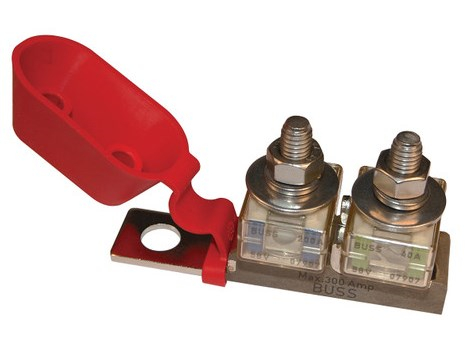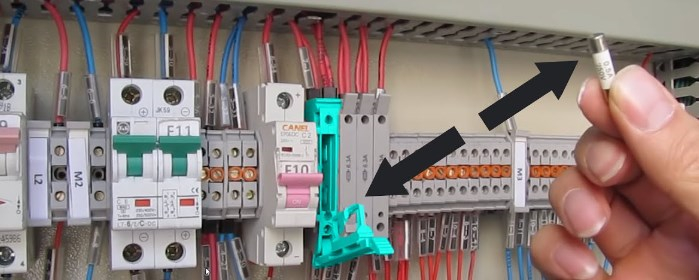Battery terminal fuse blocks offer a compelling package of safety, organization, versatility, and ease of use. Whether you're a seasoned electrician or a DIY enthusiast, incorporating these versatile tools into your electrical systems can bring significant benefits and peace of mind.

What Is Battery Terminal Fuse Blocks
Battery terminal fuse blocks are specialized components used in automotive and marine electrical systems to protect the vehicle's electrical circuits and components from overcurrent situations. These fuse blocks are typically installed at the battery terminal to provide a centralized location for fusing, helping to safeguard the electrical system from damage due to excessive current flow.
Here are some key points about battery terminal fuse blocks:
-
Protection: The primary function of a battery terminal fuse block is to protect the electrical system from overcurrent situations. In the event of a short circuit or excessive current draw, the fuse within the block will blow, breaking the circuit and preventing damage to the wiring or connected devices.
-
Installation: Battery terminal fuse blocks are typically installed directly at the positive terminal of the vehicle’s battery, providing a convenient location for fusing protection right at the power source.
-
Circuit Branching: These fuse blocks often feature multiple fuse slots or positions, allowing for the protection of various circuits connected to the main power source.
-
Fuse Types: Battery terminal fuse blocks accommodate blade-type fuses or other specific fuse styles suitable for automotive and marine applications.
-
Amperage Ratings: The fuse blocks come with different amperage ratings to suit the specific current requirements of the circuits they protect. It is crucial to select fuses with appropriate amperage ratings to ensure precise protection.
-
Sturdiness: Battery terminal fuse blocks are designed to be durable and withstand the rigors of automotive or marine environments, ensuring reliability even in challenging conditions.
-
Easy Access: By being located at the battery terminal, these fuse blocks offer easy access for fuse inspection, replacement, or troubleshooting, simplifying maintenance tasks.
-
Integration: Some battery terminal fuse blocks may feature additional functions, such as distribution points for connecting power cables to multiple circuits or grounding points for effective electrical system organization.
In summary, battery terminal fuse blocks are essential components in automotive and marine electrical systems, providing crucial overcurrent protection at the power source. By incorporating these fuse blocks into the system design, vehicle owners can prevent costly damage to electrical components and ensure the safety and reliability of the electrical system as a whole.
What Are Battery Terminal Fuse Blocks Used To
Battery terminal fuse blocks serve several important purposes in automotive and marine electrical systems. Here are some key uses of battery terminal fuse blocks:
-
Overcurrent Protection: The primary purpose of battery terminal fuse blocks is to protect the electrical system from overcurrent situations. In the event of a short circuit or excessive current draw, the fuse within the block blows, breaking the circuit and preventing damage to the wiring or connected devices.
-
Circuit Protection: Battery terminal fuse blocks protect specific electrical circuits connected to the main power source, ensuring that excessive current flows do not damage sensitive components or cause safety hazards.
-
Device Safety: By limiting the amount of current flowing through a circuit, battery terminal fuse blocks help safeguard electronic devices, equipment, and wiring from potential damage due to electrical faults.
-
System Reliability: Incorporating battery terminal fuse blocks into the electrical system enhances its reliability and longevity by preventing catastrophic failures that could result from uncontrolled current surges.
-
Electrical System Organization: Fuse blocks provide a centralized location for fusing at the battery terminal, simplifying the organization and maintenance of the electrical system. They offer a convenient point for securing fuses and managing circuit protection.
-
Maintenance Accessibility: Placing fuse blocks near the battery terminal ensures easy access for fuse inspection, replacement, or troubleshooting. This accessibility facilitates quick maintenance and minimizes downtime in case of fuse failures.
-
Circuit Branching and Distribution: Some battery terminal fuse blocks feature multiple fuse slots or positions, enabling the protection of various circuits connected to the main power supply. Additionally, they may provide distribution points for efficiently connecting power cables to multiple circuits.
-
System Protection in Harsh Environments: Battery terminal fuse blocks are designed to withstand the environmental challenges of automotive and marine applications, providing reliable overcurrent protection even in rugged conditions.
In summary, battery terminal fuse blocks are critical components that play a vital role in protecting electrical circuits, devices, and wiring in automotive and marine systems. By incorporating these fuse blocks into the system design, vehicle owners can prevent electrical system damage, ensure safety, and maintain the reliability of the entire electrical system.

The Benefits Of Using Battery Terminal Fuse Blocks
sing battery terminal fuse blocks in automotive and marine electrical systems offers several benefits that enhance system safety, protect components, and streamline maintenance. Here are some key advantages of incorporating battery terminal fuse blocks:
-
Overcurrent Protection: Battery terminal fuse blocks serve as a crucial line of defense against overcurrent situations, helping to prevent damage to wiring, devices, and sensitive electronic components in the event of a short circuit or excessive current flow.
-
Component Protection: By limiting the amount of current that can pass through the circuit, fuse blocks help protect vital components within the electrical system from damage caused by electrical faults or power surges.
-
Enhanced Safety: The use of battery terminal fuse blocks contributes to overall system safety by reducing the risk of electrical fires, short circuits, and other hazards that can arise from unregulated current flow.
-
System Reliability: Fuse blocks improve system reliability by providing a structured approach to circuit protection, minimizing the likelihood of system failures due to electrical faults and ensuring consistent performance under various operating conditions.
-
Easy Maintenance: Battery terminal fuse blocks offer a centralized and easily accessible location for fuses, simplifying maintenance tasks such as fuse inspection, replacement, and troubleshooting. This accessibility helps reduce downtime and facilitate rapid repairs as needed.
-
Circuit Organization: Incorporating fuse blocks at the battery terminal enables the organization of electrical circuits and provides a convenient point for managing fuses, connections, and circuit protection devices, promoting a tidy and well-structured electrical system layout.
-
Customization and Flexibility: Battery terminal fuse blocks come in various configurations, sizes, and amperage ratings, allowing for customization based on specific application requirements. This flexibility enables tailored protection solutions for different circuit needs.
-
Environmental Durability: Designed to withstand the rigors of automotive and marine environments, battery terminal fuse blocks are built to be durable and reliable in challenging conditions, ensuring consistent performance in harsh operating environments.
-
Preventative Maintenance: By acting as a safeguard against electrical faults, battery terminal fuse blocks help prevent costly damage to the electrical system, thereby reducing the need for extensive repairs and ensuring the longevity of components and wiring.
In conclusion, the use of battery terminal fuse blocks offers a host of benefits that contribute to system protection, reliability, safety, and ease of maintenance in automotive and marine electrical systems. By integrating these components into the system design, vehicle owners can enhance overall system performance and mitigate potential risks associated with electrical malfunctions.
Conclusion
In conclusion, integrating battery terminal fuse blocks into automotive and marine electrical systems provides a range of important benefits that enhance safety, protect components, streamline maintenance, and improve overall system reliability. These fuse blocks offer crucial overcurrent protection, safeguarding against electrical faults and potential damage caused by short circuits or power surges.
By incorporating fuse blocks at the battery terminal, system designers and users can enjoy easy access for inspection, replacement, and troubleshooting of fuses, contributing to efficient maintenance practices and reducing downtime. The organization of circuits and centralized protection provided by fuse blocks help in creating a structured and well-managed electrical system layout.
Moreover, the flexibility and customization options offered by battery terminal fuse blocks enable tailored solutions to meet specific application requirements, while their durability in harsh environments ensures continued performance and longevity in demanding operating conditions. Ultimately, the use of battery terminal fuse blocks serves as a proactive measure in maintaining system integrity, reducing the risk of damage, and promoting a safer and more reliable operation in automotive and marine electrical systems.



